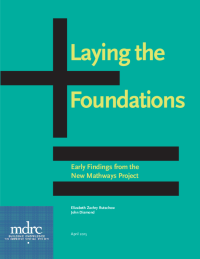Laying the Foundations
Early Findings from the New Mathways Project

National studies reveal that 50 percent to 70 percent of community college students are required to take developmental, or remedial, math courses upon enrollment, and only 20 percent of developmental math students ever successfully complete a college-level math course. Recent reforms have sought to improve students’ success rate by revising developmental math course structure and sequence into compressed instructional modules or multiweek (rather than semester-long) courses, or by placing developmental students into college-level classes with added supports. Though these initiatives have shown some promise, they have seldom addressed the math content of developmental and college-level math courses, which emphasize algebra rather than the quantitative literacy and statistics skills required in most of today’s professions.
Taking up the challenge in all three areas is the New Mathways Project (NMP), developed by the Charles A. Dana Center at the University of Texas at Austin in partnership with the Texas Association of Community Colleges. This new initiative aims to change the standard pathways to and through colleges’ traditional math sequences. Key to the work is the implementation of differentiated math course sequences that are closely aligned with the requirements of different academic and eventual career paths: a Statistical Reasoning pathway, appropriate for students in social sciences careers, such as allied health, government, or psychology; a Quantitative Reasoning pathway for students in humanities or general liberal arts fields; and a Science, Technology, Engineering, and Mathematics (STEM-Prep) pathway for students pursuing careers that require strong algebraic skills, such as chemistry, computer science, or engineering. The Dana Center is supporting implementation at the institutional level through tools, resources, and services focused on planning, staff training, curricula, and instruction. And because these reforms have important consequences for students’ ability to transfer credits to four-year colleges and universities, the Dana Center is working at the state level to identify and address key policy obstacles such as the course requirements for different majors in four-year institutions.
This report analyzes the development of the NMP from spring 2012 through its first year of rollout at nine colleges in Texas in 2013-2014, as well as student outcomes at the colleges before and during the first year. Overall, this study found that the Dana Center made significant progress in laying the groundwork for the implementation of multiple math pathways in Texas, helping foment change in how two-year and four-year colleges view students’ math requirements. To be sure, the Dana Center has work to do to reach its ambitious goals to scale up the initiative, as colleges met with obstacles around student recruitment, faculty reservations about course content, and the applicability of the pathways for students transferring to four-year colleges. Yet as of fall 2014, 20 Texas community college systems were offering at least one NMP course,[1] and descriptive outcome data reveal promising results in NMP students’ developmental and college-level course completion, with 30 percent of students completing both courses in the first year.
[1]In multi-institution systems, generally only one or two campuses were implementing an NMP pathway.






